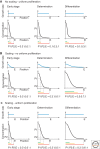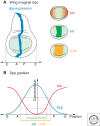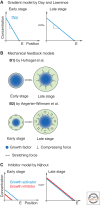Regulation of organ growth by morphogen gradients
- PMID: 20182606
- PMCID: PMC2827898
- DOI: 10.1101/cshperspect.a001669
Regulation of organ growth by morphogen gradients
Abstract
Morphogen gradients play a fundamental role in organ patterning and organ growth. Unlike their role in patterning, their function in regulating the growth and the size of organs is poorly understood. How and why do morphogen gradients exert their mitogenic effects to generate uniform proliferation in developing organs, and by what means can morphogens impinge on the final size of organs? The decapentaplegic (Dpp) gradient in the Drosophila wing imaginal disc has emerged as a suitable and established system to study organ growth. Here, we review models and recent findings that attempt to address how the Dpp morphogen contributes to uniform proliferation of cells, and how it may regulate the final size of wing discs.
Figures




Similar articles
-
Dynamics of Dpp signaling and proliferation control.Science. 2011 Mar 4;331(6021):1154-9. doi: 10.1126/science.1200037. Science. 2011. PMID: 21385708
-
Is Drosophila Dpp/BMP morphogen spreading required for wing patterning and growth?Bioessays. 2023 Sep;45(9):e2200218. doi: 10.1002/bies.202200218. Epub 2023 Jul 14. Bioessays. 2023. PMID: 37452394 Review.
-
Scaling morphogen gradients during tissue growth by a cell division rule.Development. 2014 May;141(10):2150-6. doi: 10.1242/dev.107011. Development. 2014. PMID: 24803660
-
BMP morphogen gradients in flies.Cytokine Growth Factor Rev. 2016 Feb;27:119-27. doi: 10.1016/j.cytogfr.2015.11.003. Epub 2015 Nov 24. Cytokine Growth Factor Rev. 2016. PMID: 26684043
-
The wing and the eye: a parsimonious theory for scaling and growth control?Wiley Interdiscip Rev Dev Biol. 2015 Nov-Dec;4(6):591-608. doi: 10.1002/wdev.195. Epub 2015 Jun 24. Wiley Interdiscip Rev Dev Biol. 2015. PMID: 26108346 Review.
Cited by
-
Dpp spreading is required for medial but not for lateral wing disc growth.Nature. 2015 Nov 19;527(7578):317-22. doi: 10.1038/nature15712. Epub 2015 Nov 9. Nature. 2015. PMID: 26550827
-
Decapentaplegic (dpp) regulates the growth of a morphological novelty, beetle horns.Dev Genes Evol. 2011 May;221(1):17-27. doi: 10.1007/s00427-011-0355-7. Epub 2011 Mar 12. Dev Genes Evol. 2011. PMID: 21399983
-
Mechanosensitive mechanisms in transcriptional regulation.J Cell Sci. 2012 Jul 1;125(Pt 13):3061-73. doi: 10.1242/jcs.093005. Epub 2012 Jul 13. J Cell Sci. 2012. PMID: 22797927 Free PMC article. Review.
-
The Hippo Signaling Pathway in Development and Disease.Dev Cell. 2019 Aug 5;50(3):264-282. doi: 10.1016/j.devcel.2019.06.003. Dev Cell. 2019. PMID: 31386861 Free PMC article. Review.
-
Modern perspectives on near-equilibrium analysis of Turing systems.Philos Trans A Math Phys Eng Sci. 2021 Dec 27;379(2213):20200268. doi: 10.1098/rsta.2020.0268. Epub 2021 Nov 8. Philos Trans A Math Phys Eng Sci. 2021. PMID: 34743603 Free PMC article. Review.
References
-
- Adachi-Yamada T, O'Connor MB 2002. Morphogenetic apoptosis: A mechanism for correcting discontinuities in morphogen gradients. Dev Biol 251:74–90 - PubMed
-
- Adachi-Yamada T, Fujimura-Kamada K, Nishida Y, Matsumoto K 1999. Distortion of proximodistal information causes JNK-dependent apoptosis in Drosophila wing. Nature 400:166–169 - PubMed
-
- Aegerter-Wilmsen T, Aegerter CM, Hafen E, Basler K 2007. Model for the regulation of size in the wing imaginal disc of Drosophila. Mech Dev 124:318–326 - PubMed
-
- Affolter M, Basler K 2007. The Decapentaplegic morphogen gradient: From pattern formation to growth regulation. Nat Rev Genet 8:663–674 - PubMed
-
- Agrawal N, Joshi S, Kango M, Saha D, Mishra A, Sinha P 1995. Epithelial hyperplasia of imaginal discs induced by mutations in Drosophila tumor suppressor genes: Growth and pattern formation in genetic mosaics. Dev Biol 169:387–398 - PubMed
Publication types
MeSH terms
Substances
LinkOut - more resources
Full Text Sources
Molecular Biology Databases
